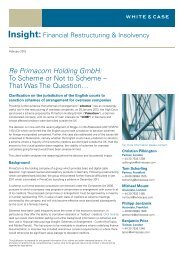Mexican Legal Framework of Business Insolvency - White & Case
Mexican Legal Framework of Business Insolvency - White & Case
Mexican Legal Framework of Business Insolvency - White & Case
You also want an ePaper? Increase the reach of your titles
YUMPU automatically turns print PDFs into web optimized ePapers that Google loves.
112<br />
b. During <strong>Insolvency</strong><br />
Aside from the duties to cooperate with the visitor, conciliator and receiver to<br />
enable them to perform their duties, directors have no liability with creditors during<br />
insolvency proceedings.<br />
During the course <strong>of</strong> insolvency proceedings, even during conciliation where<br />
management remains in possession <strong>of</strong> the enterprise, the duties <strong>of</strong> directors do not<br />
change or expand in favor <strong>of</strong> creditors. The conciliator and the conservators, if appointed,<br />
have oversight <strong>of</strong> the transactions carried out during the conciliatory stage, and the<br />
conciliator even has the remedy <strong>of</strong> demanding removal (cfr. 16.a) in cases where the<br />
conciliator considers it to be for the benefit <strong>of</strong> the estate [LCM 81].<br />
32. Mergers & Acquisitions 79<br />
There are three time frames relevant to discussing issues surrounding mergers and<br />
acquisitions (M&A) in the context <strong>of</strong> insolvency: (1) in the vicinity <strong>of</strong> insolvency; (2) during<br />
the conciliatory stage; and (3) during the liquidation stage.<br />
a. In the Vicinity <strong>of</strong> <strong>Insolvency</strong><br />
Except for the application <strong>of</strong> avoidance powers, the <strong>Insolvency</strong> Law is unconcerned<br />
with M&A transactions in the vicinity <strong>of</strong> insolvency. Please refer to Section 15.j for an<br />
analysis <strong>of</strong> the avoidance powers rules.<br />
b. During the Conciliatory Stage<br />
There are two levels <strong>of</strong> authority for disposing <strong>of</strong> assets during conciliation: (1) in the<br />
ordinary course <strong>of</strong> business; and (2) out <strong>of</strong> the ordinary course <strong>of</strong> business. The debtor<br />
is entitled to dispose <strong>of</strong> assets in the ordinary course <strong>of</strong> business, but will require the<br />
conciliator’s consent to dispose <strong>of</strong> assets out <strong>of</strong> the ordinary course <strong>of</strong> business<br />
79 Reiss (2009) provides an in-depth analysis <strong>of</strong> distressed M&A transactions, which the reader is encouraged<br />
to consult.
















